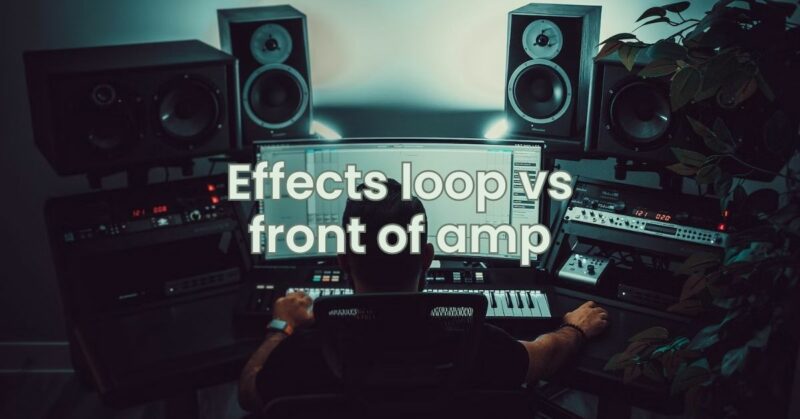Effects pedals are an essential part of many guitarists’ rigs, allowing them to shape and enhance their tone. When connecting pedals to an amplifier, there are two primary methods: the front of the amp and the effects loop. Each approach offers distinct advantages and considerations. In this article, we’ll delve into the differences between the effects loop and the front of the amp, helping you make informed decisions on how to optimize your pedal setup for the best sound.
Front of the Amp
Connecting pedals to the front of the amplifier is the most common and straightforward method. In this setup, the guitar’s signal travels through the pedals before reaching the amp’s input. This configuration allows you to add various effects, such as overdrive, distortion, modulation, and time-based effects (delay, reverb) directly to your guitar’s original signal.
Advantages of Front-of-Amp Setup:
- Simplicity: Plugging your pedals into the front of the amp is easy and intuitive, making it an ideal choice for beginners and players who prefer a straightforward setup.
- Compatibility: Most pedals are designed to work well when connected directly to the amp’s input, ensuring seamless integration.
- Distortion Stacking: Placing distortion or overdrive pedals in front of the amp can lead to “stacking” effects, where the amp’s natural overdrive can be enhanced or shaped by the pedal’s characteristics.
- Easy Access: Adjusting pedal settings is convenient, as the pedals are right in front of you, making it simple to tweak your sound on the fly.
Effects Loop
Many amplifiers, especially tube amps and higher-end models, come equipped with an effects loop. The effects loop allows you to place certain pedals after the amp’s preamp stage, but before the power amp stage. Typically, time-based effects like delay and reverb are best suited for the effects loop.
Advantages of Effects Loop:
- Preserve Clean Tone: Placing time-based effects in the effects loop allows you to maintain a clean and unaffected guitar tone while still enjoying the benefits of your pedals.
- Preamp Control: By connecting pedals to the effects loop, you can shape the sound of your amp’s preamp without affecting the signal going into the power amp. This setup offers more control over your tone.
- Noise Reduction: Some high-gain pedals can introduce noise when placed in front of the amp. The effects loop can help reduce such noise, as the pedals only process the post-preamp signal.
- Wet/Dry Balance: Using the effects loop allows you to achieve a wet/dry balance, where the dry signal (untouched by pedals) blends with the wet signal (processed by pedals). This creates a more dynamic and spacious sound.
When to Use Each Method:
- Use the front of the amp when: Connecting overdrive, distortion, fuzz, modulation, and most other pedals. It’s the go-to method for a standard pedal chain and offers simplicity and easy access to pedal settings.
- Use the effects loop when: Utilizing time-based effects such as delay and reverb. Placing these pedals in the effects loop helps maintain a clean guitar signal while adding a sense of depth and space to your sound.
Conclusion
The choice between the effects loop and the front of the amp ultimately depends on the type of pedals you’re using and your tonal preferences. For most effects, the front of the amp is the way to go, providing compatibility and straightforward setup. However, when incorporating time-based effects and seeking to preserve your clean tone, the effects loop offers distinct advantages.
Experimentation is key to finding your perfect pedal setup. Try different configurations, listen closely to the results, and let your ears guide you toward the best choice for your unique sound. Whether you choose the front of the amp, the effects loop, or a combination of both, the right setup will enhance your playing and inspire your musical creativity.


